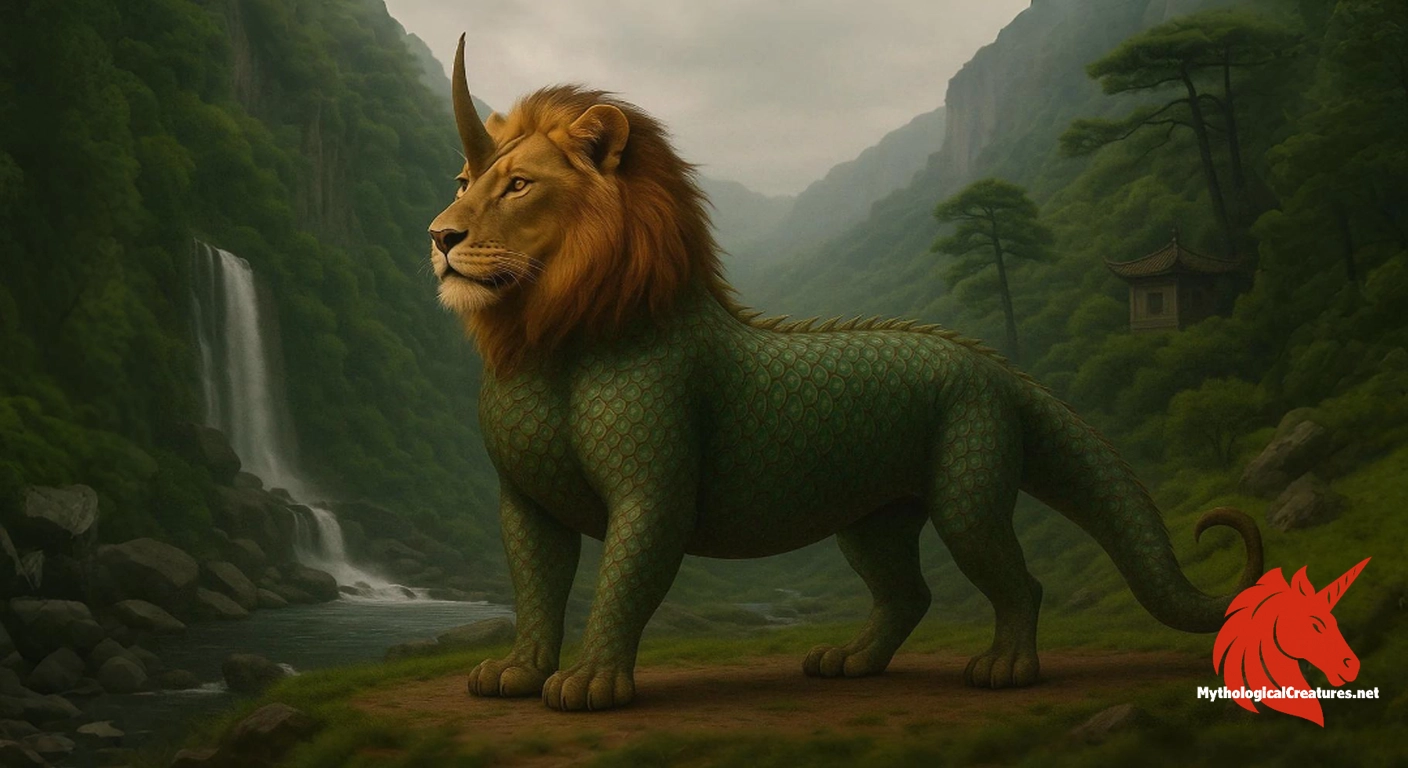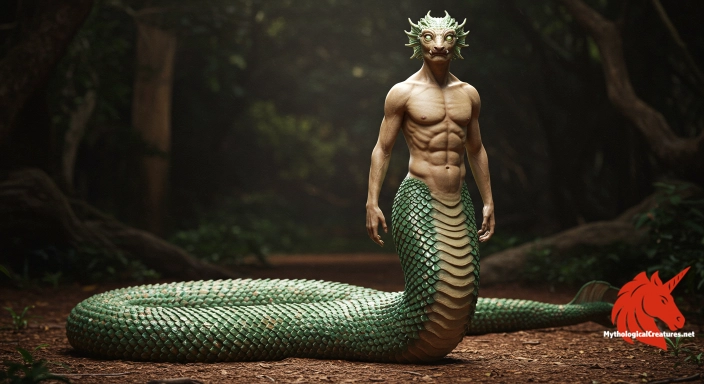Luduan: The Luduan is a legendary Chinese composite creature defined by its amalgamation of various animal parts.

Luduan
Luduan - Represents auspiciousness, divine intervention, and imperial legitimacy in Chinese folklore.
Origins & First Encounters
The Luduan emerges in Chinese myth as a mesmerizing symbol of fortune and cosmic balance, intertwining the noble attributes of several revered animals into one legendary creature. Its composite design, blending the fierce head of a lion, the steadfast horn of a rhinoceros, the serpentine body of a dragon, the imposing paws of a bear, the luminous scales of a fish, and the robust tail of an ox, offers insight into a tradition that celebrates multiplicity and harmony. Ancient narratives suggest that this creature revealed itself during eras of enlightened rule, where its appearance was seen as an omen of prosperous and just governance. The presence of the Luduan in royal iconography, such as on the incense burners of the Emperor’s throne in the Hall of Supreme Harmony, underscores its close ties with dynastic legitimacy and auspicious symbolism. Stories passed down through generations recount its ability to inspire leaders and calm the tides of ambition, even influencing formidable figures in history. Its earliest attestations blend oral history with imperial documentation, enriching the tapestry of Chinese mythology. The creature’s legacy is amplified by its depiction in traditional art and literature, showing an ever-evolving narrative that adapts to the cultural and political landscapes of its time. Every element of the Luduan, drawn from powerful real animals, is imbued with moral and spiritual significance, making it a lasting emblem of balanced might and benevolence. Its myth continues to captivate and educate, reflecting ancient ideals that remain influential in modern cultural expressions.
Source Texts & Tale Variants
Historical records, classical manuscripts, and artistic relics collectively form the primary sources that detail the lore of the Luduan. Ancient imperial chronicles occasionally reference its apparition during pivotal moments in the reigns of visionary leaders. Traditional folktales have been transmitted orally through generations before being documented, creating rich variants about its miraculous powers. Some manuscripts depict the Luduan as a celestial mediator capable of uniting diverse peoples through its gift of language and travel. A well-known variant recounts how the creature influenced the ambitions of a great conqueror, steering him away from further conflicts. Texts from various eras provide nuanced descriptions, sometimes emphasising its role as a guardian of harmony and, at other times, as a symbol of transformative change. Its visual depiction in temple reliefs and court artefacts further corroborates its esteemed presence in cultural memory. Poetic compositions and regional legends lend additional layers to its myth by focusing on its cosmic journey and multifaceted nature. Several story cycles interweave its characteristics with lessons on virtue and enlightened leadership. The enduring appeal of the Luduan is reflected in the diverse narrative strands that continue to inspire reinterpretations in both scholarly and popular contexts.
Form & Powers
The physical form of the Luduan is a striking confluence of traits drawn from some of nature’s most formidable creatures. Its lion-like head exudes regality and fierceness, with eyes that seem to hold the wisdom of ages. A single, curved horn reminiscent of a rhinoceros extends from its brow, symbolising unyielding strength and resilience. The creature’s body, fashioned after the sinuous form of a dragon, radiates an air of mysticism and authority. Powerful bear-like paws lend a sense of grounding, reflecting both protective might and stability. The intricate fish scales that cover parts of its form shimmer in a way that suggests ethereal brilliance and secret depths. A sturdy ox tail completes this composite, providing balance and reinforcing the creature’s robust character. Each anatomical feature is rendered with meticulous attention to detail, ensuring that the Luduan is both visually awe-inspiring and rich in symbolic meaning. Across depictions, variations in size and detail are apparent, yet the overall impression is one of harmonious synthesis and majestic power. This impressive amalgam of physical attributes serves as a visual testament to the layered symbolism embedded in ancient Chinese mythology.
Regional Faces
The legend of the Luduan has evolved distinctively across various regions, reflecting local mythologies and cultural sensibilities. In northern China, portrayals typically emphasise a more muscular build and an almost warrior-like presence, mirroring the rugged landscapes and sturdy lifestyles of the local inhabitants. In contrast, southern interpretations often highlight grace and fluidity, aligning the creature more closely with the softer aesthetics of regional folklore. Some communities have adapted the Luduan’s image to incorporate features that resonate with local religious or spiritual beliefs, such as added celestial motifs or artistic embellishments. Rural legends sometimes paint the creature as a benevolent guardian whose appearance is linked with bountiful harvests and communal celebrations. Town and village festivals have at times celebrated its myth, using it as a positive sign for prosperity and protection throughout the year. Local artisans incorporate regional tastes into depictions of the Luduan, varying aspects like scale design or horn curvature to suit cultural narratives. These diverse renditions highlight the adaptability of the myth, showing how it absorbs and reflects the values and traditions of different communities. Such regional variations ensure that the creature remains a dynamic and living symbol within the vast tapestry of Chinese myth. The evolving iconography of the Luduan serves as a bridge, connecting ancient imperial imagery with the local folklore of communities spread across China.
Cultural Parallels
When examined alongside other mythological beings, the Luduan reveals fascinating parallels that underline a universal human fascination with hybrid creatures. Its composite form shares similarities with the Chinese Qilin and the Japanese Kirin, both heralded as symbols of purity, benevolence, and divine rule. Elements of its design can also be compared to the mythological Chimera of Greek lore, which similarly fuses attributes of various animals to embody complex virtues and powers. Like the Narasimha in Indian mythology, the Luduan unites contrasting elements to convey the interplay of strength and mercy. In many cultures, the blending of disparate animal traits in a single entity is used to symbolise a harmonious balance between competing forces, a concept that resonates globally. The Luduan’s portrayal, with its record of traversing vast distances and speaking many languages, draws comparisons with universal motifs of transcending boundaries in both time and space. Many comparative legends underscore the role of such creatures as intermediaries between the mortal and divine worlds. Both Eastern and Western narratives utilise these hybrid beings to reflect societal ideals and cosmic order. Each element in the Luduan’s form is purposefully chosen to mirror a corresponding virtue seen in similar global legends. Through these comparative analyses, the Luduan stands as a testament to how mythic hybridisation serves as a powerful metaphor for unity, strength, and enlightened leadership across diverse traditions.
Legacy & Modern Evolution
The enduring legacy of the Luduan has seen its myth highlighted in both ancient imperial contexts and modern cultural expressions. Over the centuries, its portrayal has been refined and reinterpreted by successive dynasties, each layering new symbolic meanings onto its already rich iconography. The creature was once immortalised in the intricate design of royal artefacts, such as the incense burners in the Grand Hall of Supreme Harmony, which continue to evoke a sense of grandeur and auspicious power. Historical records recount dramatic interventions by the Luduan, including legendary episodes that influenced the course of empires, thereby cementing its status as a harbinger of fate. In contemporary settings, artists and designers often draw on the Luduan’s composite imagery to evoke themes of unity, resilience, and mystical beauty. Modern adaptations in literature, film, and even digital media have reimagined the creature as a symbol that transcends traditional boundaries, appealing to audiences far beyond its original cultural context. Cultural festivals, public monuments, and museum exhibitions frequently celebrate the imaginative legacy of the Luduan as an inspirational figure. Its multifaceted symbolism continues to influence both scholarly discourse and popular art, creating a bridge between the ancient and the modern. The evolution of the Luduan from a purely mythological figure to a contemporary emblem of hope and transformation underscores its timeless relevance. This dynamic interplay between history and modernity ensures that the Luduan remains a captivating and enduring icon in the global landscape of myth and art.
Interesting Fact
One fascinating aspect of the Luduan is its ability to communicate in every language, a trait that not only signifies its omniscience but also its universal appeal across cultures.
Quick Creature Info
Features:
Associations:
Our Mythic Legendary Rating:

Also Sometimes Known As:
Habitat:
Supernatural Powers:
Physical Attributes:
Abilities:
Behavior:
Lore:
Related Creatures, Tales or Lore
- QQilin
- KKirin
- CChinese Dragon
References
Discover Another Mythical Legend You May Not Have Heard Of?
Uncover the mysteries of ancient folklore and expand your knowledge of legendary beings from cultures around the world.
Dare to Meet the Mahoraga....
Mythical Disclaimer: The images and data on this site are derived from various historical and literary sources, but we have found that many myths often have multiple versions and interpretations across references, sometimes contradictory. As a result, these creature depictions are artistic interpretations—imaginative blends of folklore, legend, and a dash of AI guesswork. Because creature descriptions vary widely, our illustrations and accompanying information represent our best effort to honor mythology while bridging creative gaps. Enjoy these interpretations—just remember, we've done our best to respect the stories and validate available data, but in the realm of mythology, details often shift, imagination leads the way, and nothing is ever set in stone!
Curated by the Mythological Creatures Team (rev. May 2025)
